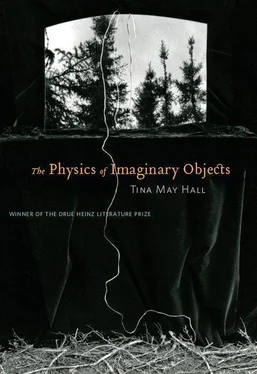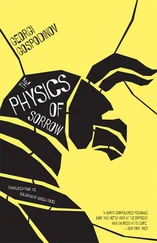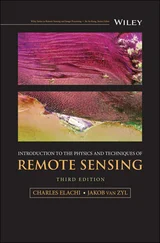Tina Hal - The Physics of Imaginary Objects
Здесь есть возможность читать онлайн «Tina Hal - The Physics of Imaginary Objects» весь текст электронной книги совершенно бесплатно (целиком полную версию без сокращений). В некоторых случаях можно слушать аудио, скачать через торрент в формате fb2 и присутствует краткое содержание. Год выпуска: 2010, Издательство: University of Pittsburgh Press, Жанр: Современная проза, на английском языке. Описание произведения, (предисловие) а так же отзывы посетителей доступны на портале библиотеки ЛибКат.
- Название:The Physics of Imaginary Objects
- Автор:
- Издательство:University of Pittsburgh Press
- Жанр:
- Год:2010
- ISBN:нет данных
- Рейтинг книги:5 / 5. Голосов: 1
-
Избранное:Добавить в избранное
- Отзывы:
-
Ваша оценка:
- 100
- 1
- 2
- 3
- 4
- 5
The Physics of Imaginary Objects: краткое содержание, описание и аннотация
Предлагаем к чтению аннотацию, описание, краткое содержание или предисловие (зависит от того, что написал сам автор книги «The Physics of Imaginary Objects»). Если вы не нашли необходимую информацию о книге — напишите в комментариях, мы постараемся отыскать её.
The Physics of Imaginary Objects,
The Physics of Imaginary Objects — читать онлайн бесплатно полную книгу (весь текст) целиком
Ниже представлен текст книги, разбитый по страницам. Система сохранения места последней прочитанной страницы, позволяет с удобством читать онлайн бесплатно книгу «The Physics of Imaginary Objects», без необходимости каждый раз заново искать на чём Вы остановились. Поставьте закладку, и сможете в любой момент перейти на страницу, на которой закончили чтение.
Интервал:
Закладка:
While he cleared away the bodies in the kitchen, I stayed in the basement. Though I hadn't eaten yet that day, my stomach was calm. I remembered the leaking mass of squirrel upstairs. Nothing. I thought of zucchinis and tomatoes. Nothing. I imagined eating eggplant, asparagus, endive with sliced radishes. The baby squirmed a little but that was all. The sickness seemed to have disappeared, just as the books said, with no warning. My whole body, even my skin, relaxed, no longer braced against the nausea. The contractor's cousin's boots tapped on the floor above me, making trips from wall to door. I made a woodcut of a charmed house, surrounded by birds and deer and squirrels and wasps. I was working on a buck rearing upright when he called down to me that he was finished, and the knife slipped, gouging away one of the deer's legs before sliding into the thumb of my left hand. When I went upstairs to pay him, he looked at my hand wrapped in the scrap of an old t-shirt starting to seep blood, but he didn't say anything until I handed him the money, and then he said, “Thank you”—twice he said it, shyly, not meeting my eyes.
Paul called to say he was coming home. I was in the basement working on a print for a nature magazine of a man in a forest holding up an old-style lantern — lost in the snow. I struggled with the flakes falling through the tree branches — a tricky thing, determining how much to pare away. My cut thumb stung, reminded me to go slowly.
When Paul walked into the kitchen, he gasped at the hole in the wall and the smell that lingered. It was clear we were not going to be able to stay in the house. He stood in the center of the room, looking around, and I saw him touch the table, noticing it was shifted from its usual space.
There was no use in taking anything with us because the smell had permeated everything. His house was only a few miles through the woods, and we decided to celebrate the first real snowfall by snowshoeing there. It was already night. The air was so cold the trees cracked. Above us, the gibbous moon, deflating. Between us, this understanding, a tether, the thing we wouldn't talk about. I wanted to tell him about the kitchen windows, the thickness of glass, the cost of a wall filled with squirrels, the spiders claiming their corners. I wanted to tell him I loved him and I couldn't remember how we met. He had things he wanted to tell me too; I knew by the way his breath hung in the air before us. There were so many things inside us, and it comforted me to think of them there, curled up, content, for the time being, to be hidden.
Erratum: Insert “R” in “Transgressors”
Fragments from the 1899 and 1900 Transactions of the American Microscopical Society
A murder had been committed, the instrument used being an ax.
The victim was a sailor of Swedish extraction and had sailed the lakes for seven or eight years, making his home in Buffalo.
The defendant was a dancer, a singer, a woman once beautiful who, because of her tortuous course, became roughened and changed.
The victim was a sailor of Swedish extraction. He was in the habit of spending his nights when on shore at a notorious dance hall in the infected district.
I was engaged as a medical expert in an investigation under peculiar circumstances. With your kind permission, I will briefly narrate.
The poetic statement that drops of different bloods drying on a glass plate would give different figures needs only to be mentioned to show that science is not always divorced from fancy.
The victim was a sailor of Swedish extraction. He was in the habit of spending his nights in the infected district. One night he met a singer, whose husband was “the strong man” doing certain tricks such as stone-breaking, tearing chains asunder, and the like. One night the sailor met a singer, a woman, once beautiful, whose very appearance struck him a blow.
A murder had been committed, the instrument used being an ax. After the murder, the house, a wooden one, containing the body, was set on fire, burning to the ground.
I was engaged as a trained and thorough observer, called into action to help solve the seeming mystery. I was engaged for the testimony of a microscopist — one who sees, then feels — not with his fingers but with his intellectual grasp. With your kind permission, I will briefly narrate.
A murder had been committed, the instrument used being an ax. After the murder, the house, a wooden one, containing the body, was set on fire, burning to the ground. The ax had been thrown down about eight feet from the house, thus being subjected to a high heat.
I was engaged to determine the presence or absence of blood.
The defendant was a woman, a singer in a resort, whose husband was “the strong man” doing certain tricks. Her very appearance struck the sailor a blow. The sailor's was a stable body not readily affected. He was of Swedish extraction. He had sailed the lakes for seven or eight years.
The victim may have been the husband, “the strong man” noted for his strength, which in fact consisted only in stage tricks. One man was missing, one dead.
A trauma, be it ever so slight, is only safe as long as the pressure is low. A glance from her struck the sailor a blow. The action of the heart alone is almost never responsible. She was a singer in the infected district, which caused her to become roughened and changed.
I was engaged as a medical expert, a trained and thorough observer, called into action to help solve a seeming mystery.
One man was missing, one dead. They offer a point of least resistance, and upon the degree of resistance do their own lives and safety depend.
To determine the presence or absence of blood, one must perform the most delicate test. The action of the heart alone is almost never responsible.
A glance from her struck him a blow. One man was missing, one dead. Her husband was “the strong man” doing certain tricks, such as stone breaking, tearing chains asunder, and the like.
A chain is no stronger than its weakest link, or a bridge stronger than its weakest span, or a man stronger than his weakest artery.
He was a sailor of Swedish extraction who was in the habit of spending his nights in the infected district. There he met women who were usually functional and temporary. She was a singer, once beautiful. They proceeded upstairs to a private room. A glance from her struck him a blow.
A bridge is no stronger than its weakest span. There can be no question about the delicacy of this reaction. The main force of the heart is spent in distending the arteries. A man is no stronger than his weakest artery. They offer a point of least resistance, and upon the degree of resistance does their own life and safety depend.
Leaving the room and descending the stairs, they met the husband who struck the sailor on the jaw, felling him. One man was missing, one dead. The house, a wooden one, was set on fire, burning to the ground. A murder had been committed, the instrument used being an ax. On the ax were charred and brittle hairs and some brownish-black spots, which, if blood, were too much altered to respond to any but the most delicate test.
I was engaged as a trained observer — one who sees, then feels — not with his fingers but with his intellectual grasp. As a stable body not readily affected. As a microscopist and a medical expert. With your kind permission, I will briefly narrate.
Practically everything can be accomplished with the small direct vision.
One man was missing, one dead. The woman was a singer, once beautiful, capable of striking a blow with a glance. The instrument used being an ax. Her husband was “the strong man,” noted for his strength, which in fact consisted only in stage tricks. He struck the sailor on the jaw, felling him. On the ax were brownish-black spots. The test is certain and quite delicate. The sailor was of Swedish extraction and had sailed the lakes. A bridge is no stronger than its weakest span.
Читать дальшеИнтервал:
Закладка:
Похожие книги на «The Physics of Imaginary Objects»
Представляем Вашему вниманию похожие книги на «The Physics of Imaginary Objects» списком для выбора. Мы отобрали схожую по названию и смыслу литературу в надежде предоставить читателям больше вариантов отыскать новые, интересные, ещё непрочитанные произведения.
Обсуждение, отзывы о книге «The Physics of Imaginary Objects» и просто собственные мнения читателей. Оставьте ваши комментарии, напишите, что Вы думаете о произведении, его смысле или главных героях. Укажите что конкретно понравилось, а что нет, и почему Вы так считаете.












